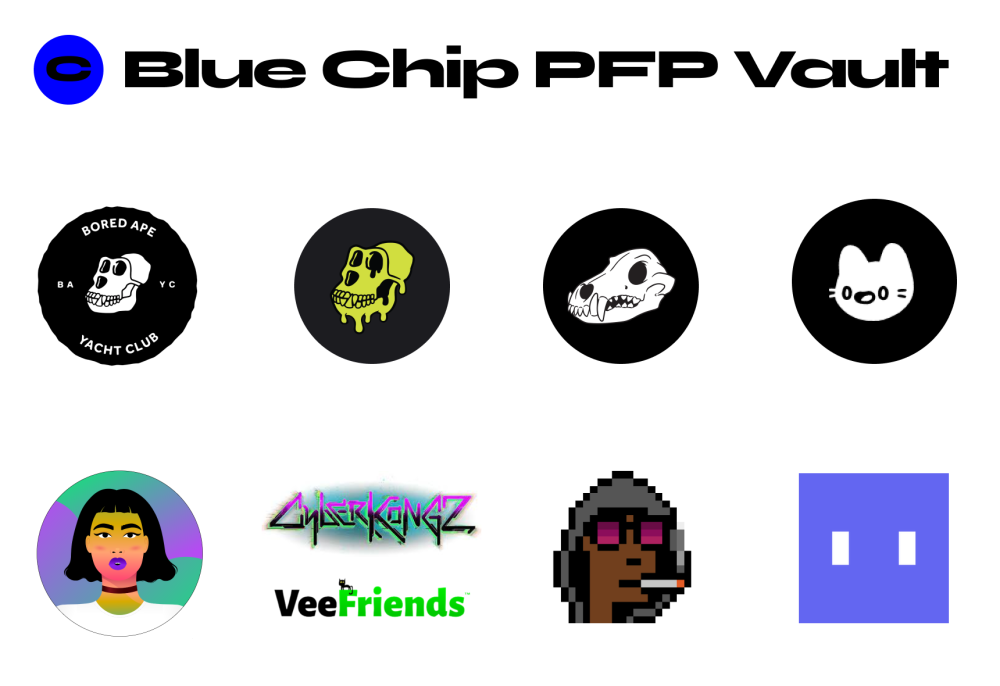gm 👋
In this article, we’d like to share details on Cyan’s vaults, which are unique and require a bit of explaining.
Vaults will exist as a way to fund buy now, pay later (“BNPL”) plans and pawn (“Pawn”) plans. At launch, vaults will only accept ETH, with more options coming very soon. The interest paid on BNPL and Pawn plans is directly passed through to the vaults, with no transaction or platform fees in between. We only ask for a small servicing fee of 0.30% when staking, which covers the various gas fees required to move funds. The vault will also accumulate defaulted NFTs from BNPL and Pawn plans along the way, with specifics below on how defaulted NFTs are handled.
Each vault will have a unique category, such as Blue-Chip PFP Vault and Digital Land Vault. Staked crypto in each of these vaults will be used to fund the BNPL and Pawn plans for each respective project. For example, a BAYC ape would be funded by the Blue-Chip PFP Vault, while a Sandbox plot of land would be funded by the Digital Land Vault. This makes staking easier for the community, along with the benefit of natural indexing and diversification of NFT projects.

Criteria for the selection for each vault are determined by a list of quantitative factors, including but not limited to the number of items in the collection, dispersion of ownership, floor price volatility, traded volumes, and other metrics. In addition, qualitative characteristics are considered, such as the age of the collection, the rarity of the underlying item, the number of engagements in the community, and so forth. You can find which projects fall under which vault in our docs.
To ensure the supply-demand dynamic for capital is priced fairly, each vault has a safety rate, which will manage how much ETH is kept as a buffer and reserve. The default safety rate is set to 20%, meaning 20% of currently deployed capital is held as ETH. The safety rate may be adjusted higher in conditions that warrant protection from risk, with the max possible limit of 100%. For idle ETH that hasn’t been deployed, it will be converted to stETH to maximize yield. In other words, stakers who usually stake into Lido’s stETH will have the same exposure within the vaults when capital is not in demand within Cyan.
Defaulted NFTs from abandoned BNPL or Pawn plans will be the property of the vaults. To start, Cyan will act as a proxy to diligently unwind the NFT in an open marketplace, such as OpenSea, and list the item within three days of the default event. When a defaulted NFT reaches a vault, the Cyan wallet will request the vault for the NFT, and manage the direct listing until sold on the marketplace. The listing price will be determined at the time of listing, using our appraisal pricing logic driven by our risk models. Until the defaulted NFT is sold, it will be marked to market using our appraisal value logic, daily or more frequently depending on the velocity of price movement. Once the NFT is sold, funds will be transferred back to the respective vault, along with updating the mark-to-market value of the NFT to zero.
Initial minting for each vault token will be handled by Cyan, with the default seed amount being 3 ETH, at a 1:1 ratio to ETH. This means the starting price of one vault token will equal one Ethereum. Post-minting, the seeded vault tokens may be redistributed to the community or be used for marketing efforts — we want to engage with the community on its destination. The Cyan multi-signature wallet (jump to gnosis), managed by the Cyan core team (Mikio, Naba, and one advisor) on a 2/3 quorum basis, will maintain the seeded vault tokens.
Each vault token will have a unique ID, starting with CV01 for the Blue-Chip PFP Vault. Vault tokens are standard fair ERC20 and will reside in the staker’s wallet after staking ETH as a representation of participation in the vault. Before any BNPL or Pawn plans are initiated to a newly created vault, the community will have ample time and notice on Twitter and in Discord to initially stake at the 1:1 ratio prior to engagement of activity.
That’s it for now, we’ll be adding more articles soon to share. In the meantime, our docs are the best place to find more specifics about the protocol.
💙
Vault documentation: https://docs.usecyan.com/docs/vaults
Vault demo: https://www.youtube.com/watch?v=YX3ppX6GVrk